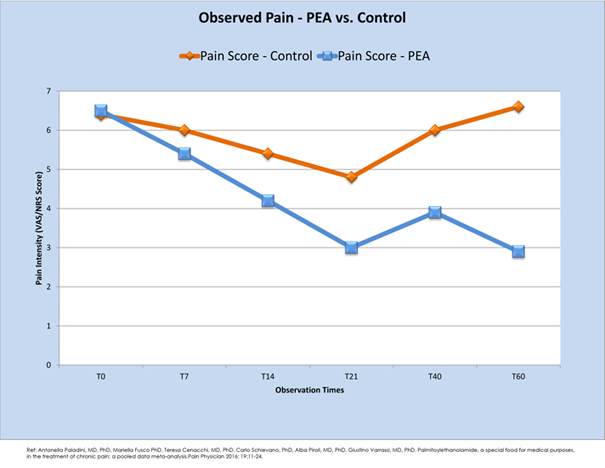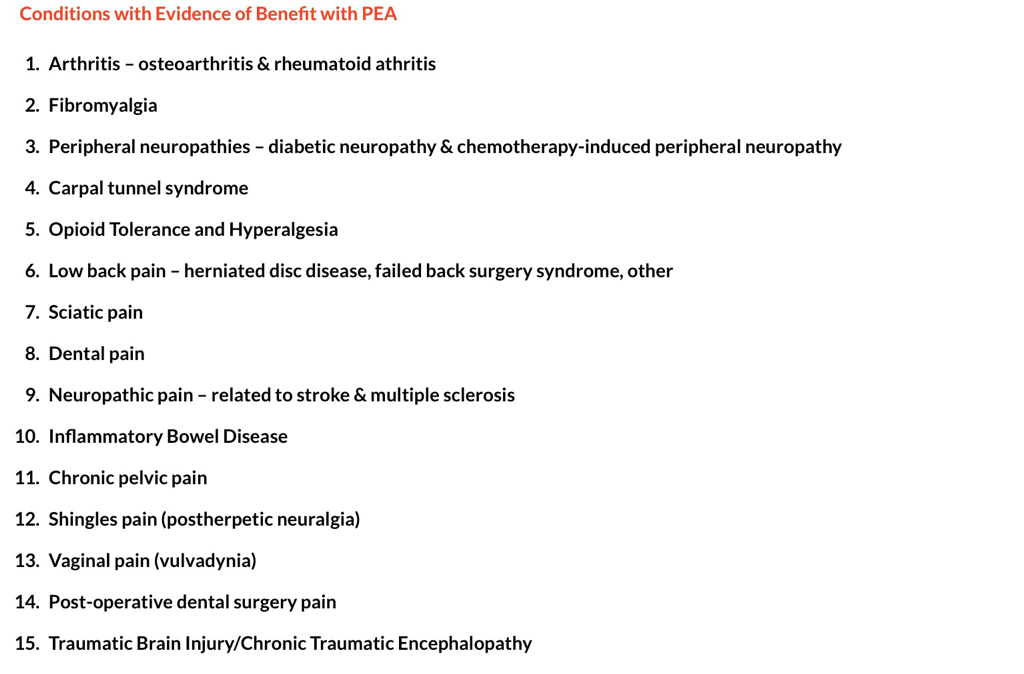What is PEA (palmitoylethanolamide)?
- An EndoCannabinoid
- Natural fatty acid amide produced by our own bodies (“Endocannabinoid Family”’)
- Produced and used locally in all our tissues in response to stress, pain and inflammation
- Works on pathways of the body’s Endocannabinoid System (ECS).
- Enhances synergistic Entourage effect of other Endo- and Phyto- Cannabinoids.
- Increases AMPK Activation, which exerts significant anti-inflammatory effects and long lasting pain relief.
- Decreases Tolerance.
- Supports symptoms of mild to moderate osteoarthritis
- Supports joint function
- Reduces joint stiffness
- Provides joint comfort
Palmitoylethanolamide (PEA) works through similar neural pathways as Hemp, which is why some say it is like Cannabis-Free “Hemp”. But unlike many Hemp products, it has been affirmed GRAS (Generally Recognized as Safe), so you know it’s entirely safe, legal, and non-habit forming.
PEA is an endogenous fatty acid amide. PEA is produced naturally by your body on demand as a biological response and accumulates and is used locally in all tissues. PEA is a first responder repair and restore mechanism to pain, stress, and inflammation. The antiinflammatory and antihyperalgesic activity of PEA indicates that this molecule is an endogenous regulator of pain and inflammation. PEA is a natural compound in food, such as eggs and milk. No serious side effects have been reported, nor have any negative interactions.
PEA plays a key role in maintaining your body's homeostasis by regulating many physiological reactions associated with pain and inflammation. Some chronic conditions can deplete PEA in the body. Depleted levels of PEA in the body results in an imbalance, which can lead to excessive activation of cells involved in the immune and inflammation response systems. This excessive activation can result in sustained pain and inflammation. PEA is structurally related to the endogenous cannabinoid transmitter, anandamide (AEA). AEA is associated with regulating pain and the more AEA in the bloodstream, the less discomfort a person may feel. PEA has numerous clinical studies demonstrating its potential as an effective and safe anti-inflammatory, analgesic and tissue-protective nutrient. PEA utilizes the endocannabinoid system, working its actions at CB1, CB2, and GPR55 receptors, and TRPV1 channels for supporting joint function, reducing joint stiffness and providing joint comfort. PEA can also contribute to relaxation and restfulness leading to a better quality of sleep.
Topical PEA is ideal for local application to an affected area of skin, muscle, or joints. PEA applied topically tends to stay concentrated in the area where it was applied. Clinical studies are confirming its therapeutic benefit in combatting pain and inflammation, as well as general well being.
PEA is an endogenous fatty acid amide. PEA is produced naturally by your body on demand as a biological response and accumulates and is used locally in all tissues. PEA is a first responder repair and restore mechanism to pain, stress, and inflammation. The antiinflammatory and antihyperalgesic activity of PEA indicates that this molecule is an endogenous regulator of pain and inflammation. PEA is a natural compound in food, such as eggs and milk. No serious side effects have been reported, nor have any negative interactions.
PEA plays a key role in maintaining your body's homeostasis by regulating many physiological reactions associated with pain and inflammation. Some chronic conditions can deplete PEA in the body. Depleted levels of PEA in the body results in an imbalance, which can lead to excessive activation of cells involved in the immune and inflammation response systems. This excessive activation can result in sustained pain and inflammation. PEA is structurally related to the endogenous cannabinoid transmitter, anandamide (AEA). AEA is associated with regulating pain and the more AEA in the bloodstream, the less discomfort a person may feel. PEA has numerous clinical studies demonstrating its potential as an effective and safe anti-inflammatory, analgesic and tissue-protective nutrient. PEA utilizes the endocannabinoid system, working its actions at CB1, CB2, and GPR55 receptors, and TRPV1 channels for supporting joint function, reducing joint stiffness and providing joint comfort. PEA can also contribute to relaxation and restfulness leading to a better quality of sleep.
Topical PEA is ideal for local application to an affected area of skin, muscle, or joints. PEA applied topically tends to stay concentrated in the area where it was applied. Clinical studies are confirming its therapeutic benefit in combatting pain and inflammation, as well as general well being.
RESEARCH ARTICLES, WITH SELECT QUOTES
Click on buttons for quote source and Full Research documents and articles.
Those with chronic pain, inflammation, and depression can see disruptions in the balance of the endocannabinoid system. . . . anandamide and PEA help modulate this system! . . . the focus now includes these other molecules.
So while many jump to (Hemp) products to modulate this same receptor system, PEA is a non-hemp derived molecule that can bring balance to this important endocannabinoid system at arguably less cost and considerably less social stigma & regulatory hurdles.
PEA is produced by the body and helps the body balance mood, inflammation, pain,
PEA has demonstrated effectiveness for chronic pain of multiple types associated with many painful conditions, especially with neuropathic (nerve) pain, inflammatory pain and visceral pain such as endometriosis and interstitial cystitis. On the forefront of research into agents that may act on neuroinflammation is palmitoylethanolamide (PEA) which has been reported to reduce mast cell activation and to control glial cell behaviors. What is particularly exciting about PEA is that it is a naturally occuring agent produced by the body that has no reported serious side effects or drug-drug interactions, making it an extraordinarily safe treatment option. Over the last few years, especially in Europe and the Netherlands, more and more clinical research and practical experience have confirmed that PEA is an effective treatment option for chronic pain.
PEA is widely distributed in different body tissues, including the nervous system, and is synthesized on demand following stress, injury and/or pain and accumulates in affected tissues with inflammation. PEA serves to reduce inflammation and pain in different chronic pain conditions..
how PEA works in the body. “It’s an endogenous fatty acid amide produced by the body in response to stressors, pain, and inflammation,” he said. “So it acts as a very good pain reliever for multiple types of pain and inflammation. It’s the body’s own anti-inflammatory and pain-control mechanism as a first responder.”
Not only that, he said, but it is produced throughout the body. “The uniqueness of PEA is that it’s an autacoid,” he said. “Autacoids are produced and used up locally in every tissue; it’s not just produced in one particular organ.” As a result, it’s produced where there is inflammation and pain in the body, he said.
He added that the ingredient is fast-acting (starts working within 15 minutes), and that its half-life is eight hours in the body; however, PEA’s effects are even longer lasting than that, he said. “It prevents the output of inflammatory cytokines and interleukins into your system, and because of this, the effects last longer because it acts on the cause, not on the symptoms,” he explained. “The half-life is eight hours in the body, but the effect you get happens throughout the day because it shuts off the source of the inflammation and the source of the pain.”
PEA, currently marketed as medical food against neuropathic pain(Petrosino and Di Marzo, 2017), counteracts pain and modifies several of the biochemical and functional changes induced by vitamin D deficiency
The therapeutic efficacy of PEA has been tested in a multitude of indications related to inflammation and pain, and, in both animal models and clinical trials, PEA has proven to be safe and effective.27–35 This compound might become a promising new therapeutic possibility for CRPS, especially considering that its targets are nonneuronal cells: the mast cell and the glia cell.19,36 Both nonneuronal cells have been recognized since the last decade as important contributors to neuropathic pain and neuroinflammation.
Palmitoylethanolamide (PEA) is an endogenous fatty acid amide that, through modulation of mast cells and spinal glial cells activation on peripheral and central nervous system neurons, has been demonstrated to be effective on the different inflammatory mechanisms that develop and maintain both neurogenic and neuropathic pain
PEA . . . performs a great variety of biological functions related to chronic and neuropathic pain and inflammation, as has been demonstrated in clinical trials. These include peripheral neuropathies such as diabetic neuropathy, chemotherapy-induced peripheral neuropathy, carpal tunnel syndrome, sciatic pain, osteoarthritis, low-back pain, failed back surgery syndrome, dental pains, neuropathic pain in stroke and multiple sclerosis, chronic pelvic pain, postherpetic neuralgia, and vaginal pains.
Conclusions: PEA was extremely efficacious on pain and function in a large cohort of patients with low back pain – sciatica.
Conclusions: This observational study provides evidence, albeit preliminary, for the efficacy and safety of um-PEA (Normast) as part of a multimodal therapeutic regimen in the treatment of pain-resistant patients
In summary, available data from rodent and human studies support the safety of PEA in general, and of microPEA specifically, in products intended for human and companion animal consumption.
Conclusion: In spite of the study’s limited sample size and the open-label design, this research suggests the efficacy of um-PEA and m(PEA/PLD) in reducing painful symptomatology and improving quality of life as well as psychological well-being in patients suffering from endometriosis.
Various studies have reported that activation of AMPK can inhibit the synthesis of proinflammatory cytokines, such as TNF-α, and IL-6 both in macrophages (52, 53), and in adipocytes (54). Here, PEA, inducing an increase in AMPK activation in adipose tissue, inhibits cytokine synthesis, reducing the activated state of macrophages. Therefore, it is conceivable that PEA-induced activation of AMPK in adipose tissue drives antiinflammatory polarization of macrophages to M2 phenotype, reverting the reduction in AMPK activation of OVX animals and the enhanced mRNA expression of TNF-α and IL-6 and increasing arginase-1 and adiponectin synthesis. Our data confirm the well-known antiinflammatory role of this acylethanolamide and evidence its novel and interesting metabolic effect at central and peripheral level.



